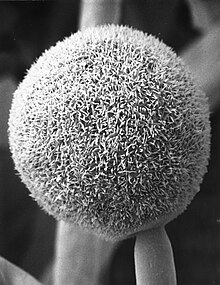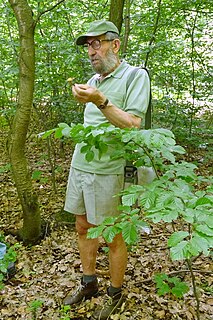| Helicostylum | |
|---|---|
 | |
| Helicostylum pulchrum | |
| Scientific classification | |
| Kingdom: | |
| Division: | |
| Class: | |
| Order: | |
| Family: | |
| Genus: | Helicostylum |
| Species | |
Helicostylum is a genus of two species of fungi in the family Mucoraceae.
| Helicostylum | |
|---|---|
 | |
| Helicostylum pulchrum | |
| Scientific classification | |
| Kingdom: | |
| Division: | |
| Class: | |
| Order: | |
| Family: | |
| Genus: | Helicostylum |
| Species | |
Helicostylum is a genus of two species of fungi in the family Mucoraceae.

Mycology is the branch of biology concerned with the study of fungi, including their genetic and biochemical properties, their taxonomy and their use to humans as a source for tinder, traditional medicine, food, and entheogens, as well as their dangers, such as toxicity or infection.

The Russulales are an order of the Agaricomycetes,. According to the Dictionary of the Fungi, the order consists of 12 families, 80 genera, and 1767 species. According to Species Fungorum, the order contains 13 families, 117 genera, and 3,060 species.

The International Plant Names Index (IPNI) describes itself as "a database of the names and associated basic bibliographical details of seed plants, ferns and lycophytes." Coverage of plant names is best at the rank of species and genus. It includes basic bibliographical details associated with the names. Its goals include eliminating the need for repeated reference to primary sources for basic bibliographic information about plant names.

Amanita porphyria, also known as the grey veiled amanita, is a fairly common, inedible mushroom of the genus Amanita found in Europe and North America.
Index Fungorum is an international project to index all formal names in the fungus kingdom. As of 2015 the project is based at the Royal Botanic Gardens, Kew, one of three partners along with Landcare Research and the Institute of Microbiology, Chinese Academy of Sciences.

Lewis David de Schweinitz was a German-American botanist and mycologist. He is considered by some the "Father of North American Mycology", but also made significant contributions to botany.

The Marasmiaceae are a family of basidiomycete fungi which have white spores. They mostly have tough stems and the capability of shrivelling up during a dry period and later recovering. The widely consumed edible fungus Lentinula edodes, the shiitake mushroom, is a member of this family. According to a 2008 estimate, the family contains 54 genera and 1590 species.

The Mucoraceae are a family of fungi of the order Mucorales, characterized by having the thallus not segmented or ramified. Pathogenic genera include Absidia, Apophysomyces, Mucor, Rhizomucor, and Rhizopus. According to a 2008 estimate, the family contains 25 genera and 129 species.
MycoBank is an online database, documenting new mycological names and combinations, eventually combined with descriptions and illustrations. It is run by the Centraalbureau voor Schimmelcultures fungal biodiversity center in Utrecht.
Elsinoe rosarum, Anthracnose, is a fungal plant pathogen. It is a condition found on roses, causing leaves to have irregular dark margins and spots. The disease usually appears during wet weather.
Phoma tracheiphila is a fungal plant pathogen. It causes a disease known as Mal secco on citrus trees. It occurs in dry, cool climates such as the Mediterranean, Black Sea and Asia Minor. It forms pycniospores that are carried short distances by rain, or by wind to new leaves, where germinated hyphae invade stomata or more likely fresh wounds.

August Johann Georg Karl Batsch was a German naturalist. He was a recognised authority on mushrooms, and also described new species of ferns, bryophytes, and seed plants.

The Ganodermataceae are a family of fungi in the order Polyporales. As of April 2018, Index Fungorum accepts 8 genera and 300 species in the family. The family was circumscribed by Dutch mycologist Marinus Anton Donk in 1948 to contain polypores with a double spore wall. The inner wall is verruculose to ornamented, thickened and usually coloured, while the outer wall is thin and hyaline.

The Pertusariales are an order of fungi in the class Lecanoromycetes. According to Species Fungorum it contains the following families: Agyriaceae, Coccotremataceae, Icmadophilaceae, Megasporaceae, Microcaliciaceae, Miltideaceae, Ochrolechiaceae, Pertusariaceae, Varicellariaceae. Many of these fungi form lichens.
Pluteus nigroviridis is a mushroom in the family Pluteaceae. Found in Europe, it was first described scientifically by Hungarian mycologist Margit Babos in 1983.

František Kotlaba was a Czech botanist and mycologist.

Morchella deliciosa is a species of edible fungus in the family Morchellaceae. It was first described scientifically by Elias Magnus Fries in 1822. It is a European species, although the name has erroneously been applied to morphologically similar North American morels.
Hygrophoropsis mangenotii is an edible gilled mushroom of the genus Hygrophoropsis native to the Ivory Coast. It was described in 1954 by Marcel Locquin.
Helicostylum elegans is a species of fungi in the family Mucoraceae.
| | This Zygomycota-related article is a stub. You can help Wikipedia by expanding it. |